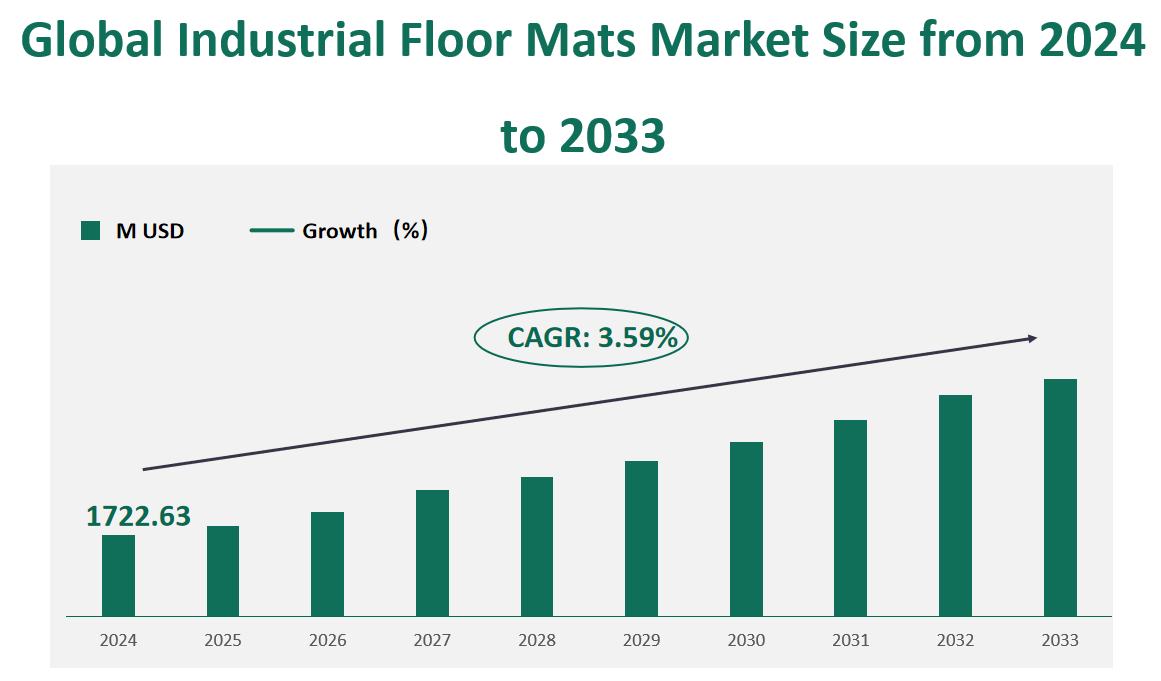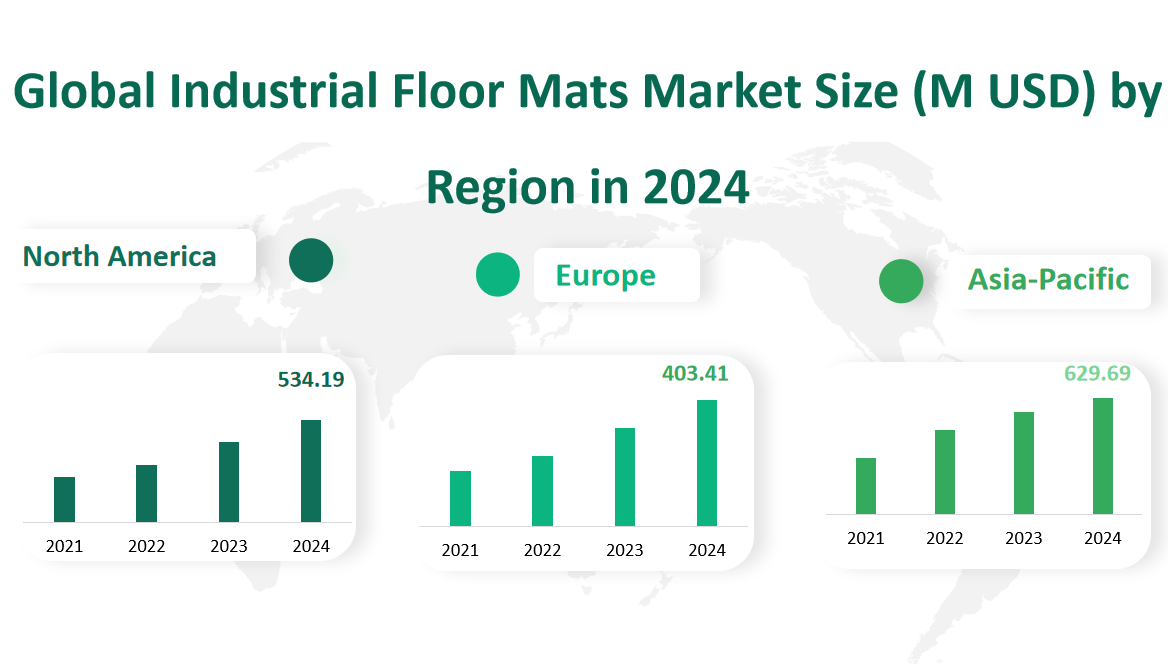1 Global Industrial Floor Mats Market Insight Analysis
The global industrial floor mats market will be valued at approximately USD 1722.63 million in 2024, with a CAGR of 3.59% from 2024 to 2033.
Industrial floor mats are specially designed floor mats that are specially used in industrial or industrial environments. The purpose is to improve the safety and protection in the industrial environment, as well as to eases fatigue in employee’s legs and feet, prevent slips and increase productivity. They may also include other functional features, such as protection against electrostatic discharge (ESD), chemical resistance, grease resistance, flame retardant, etc.
Figure Global Industrial Floor Mats Market Size (M USD) and CAGR (2024-2033)

2 Industrial Floor Mats Market Growth Drivers and Restraints
The global industrial floor mats market is experiencing significant shifts, with a variety of factors influencing its growth and development. Key drivers include the diversification of functions and broad applications, which cater to the evolving needs of industries such as food processing, manufacturing, and chemicals. The increasing demand for safety and anti-fatigue solutions in workplace environments has propelled the market forward, as regulatory compliance and safety standards become more stringent worldwide. Additionally, technological advancements have played a crucial role in enhancing the performance and durability of industrial floor mats, making them more efficient and effective in their intended applications.
However, the market also faces constraints that hinder its growth. One of the primary challenges is the lack of awareness about the benefits of industrial floor mats, particularly in potential markets where their application could be transformative. The heavyweight of these mats poses difficulties in terms of replacement and cleaning, which can be a deterrent for some industries. Furthermore, raw material price fluctuations and supply chain disruptions, particularly due to global events like the COVID-19 pandemic, have posed significant challenges to the market. The impact of these fluctuations is felt across the supply chain, affecting manufacturers’ profitability and end-users’ affordability.
3 Technological Innovations and Mergers in the Industrial Floor Mats Market
The market has made significant progress in terms of technological innovation, with companies investing in research and development to create floor mats with greater durability, slip resistance, and ergonomic properties. Customization and specialization are becoming increasingly important, with floor mats designed to meet the needs of specific industries. There is also a growing trend to use sustainable and environmentally friendly materials in the production of floor mats, reflecting global concerns about environmental issues.
Corporate activities, especially mergers and acquisitions, have played an important role in shaping the market. These activities enable companies to expand their product offerings, enter new markets, and consolidate their market positions. Mergers and acquisitions also promote synergies by integrating resources, reducing costs, and improving operational efficiency. In addition, by acquiring smaller, innovative companies, large companies can quickly integrate new technologies and product lines into their product portfolios, thereby accelerating market innovation.
In summary, the global industrial floor mat market is driven by expanding industrial demand, regulatory compliance, technological advancement, and globalization. Despite this, it still faces challenges such as lack of awareness, high initial costs, volatile raw material prices, and the impact of the epidemic. Technological innovation and corporate development M&A and restructuring activities simultaneously drive the market. Through continuous product innovation and strategic market expansion, industry leaders are able to accelerate technology integration and improve market competitiveness.
4 Global Industrial Floor Mats Market Size by Type
Anti-fatigue mats are designed to reduce standing fatigue and provide comfort to workers in industries where prolonged standing is required. In 2024, this segment is projected to generate a revenue of $584.10 million, holding a significant share in the global market. The growth can be attributed to the increasing awareness of the importance of worker comfort and safety in high-standing environments like manufacturing and food processing industries.
These mats are crucial in industries where the control of static electricity is essential to prevent damage to sensitive electronic equipment. The anti-static mat segment is expected to reach a revenue of $369.96 million in 2024. The demand for these mats is driven by the expanding electronics and semiconductor industries, where static control is a critical factor.
Traction mats, known for their slip-resistant properties, are expected to bring in $131.85 million in revenue in 2024. These mats are vital in areas prone to wet or oily conditions, such as kitchens, workshops, and loading docks, providing a safer working environment and reducing the risk of slips and falls.
Non-conductive mats whose insulating properties prevent electrical hazards, are forecasted to generate $189.55 million in 2024. Their use is prevalent in electrical substations, control rooms, and other areas where electrical safety is a concern.
Table Global Industrial Floor Mats Market Size by Type in 2024
Type | Market Size (M USD) 2024 |
|---|---|
Anti-fatigue Mats | 584.10 |
Anti-static Mats | 369.96 |
Traction Mats | 131.85 |
Non-conductive Mats | 189.55 |
Others | 447.17 |
5 Global Industrial Floor Mats Market Size by Application
The food industry requires floor mats for hygiene and safety, particularly in areas prone to wetness and slippage. In 2024, this application is forecasted to generate a revenue of $287.40 million, reflecting the industry’s strict safety standards and the need for mats that provide both comfort and cleanliness.
Manufacturing facilities often utilize heavy-duty floor mats to alleviate worker fatigue and enhance safety. The manufacturing industry is expected to contribute a revenue of $798.73 million in 2024, highlighting the significant demand for durable and reliable floor mats in this sector.
Chemical plants demand mats that are resistant to chemicals and provide stability in potentially hazardous environments. The chemical industry’s revenue share is projected to be $321.28 million in 2024, indicating the importance of specialized mats in this high-risk application.
Table Global Industrial Floor Mats Market Size by Application in 2024
Application | Market Size (M USD) 2024 |
|---|---|
Food Industry | 287.40 |
Manufacturing Industry | 798.73 |
Chemical Industry | 321.28 |
Other | 315.22 |
6 Global Industrial Floor Mats Market Size by Region
North America, with its well-established industrial sector, is expected to generate a revenue of $534.19 million in 2024. The region’s mature market is driven by the continuous demand for safety enhancements and the replacement of aging industrial infrastructure.
Europe follows closely with a projected revenue of $403.41 million in 2024. The region’s focus on worker safety and the presence of several heavy industries contribute to the demand for industrial floor mats.
Asia-Pacific is anticipated to be the largest revenue contributor with $629.69 million in 2024. The rapid industrialization and growth of manufacturing hubs in countries like China, Japan, and India have led to an increased demand for floor mats in this region.
South America is projected to generate $81.95 million in 2024. The region’s market is growing, driven by the expansion of industrial sectors and the need for improved workplace safety.
With a projected revenue of $73.38 million in 2024, the Middle East and Africa region is experiencing steady growth, attributed to the increasing focus on oil and gas industry safety and the expansion of manufacturing facilities.
The regional analysis reveals that while developed regions like North America and Europe have substantial market shares, the growth in Asia-Pacific and other developing regions is significant, indicating a shift in the global industrial landscape. The demand for industrial floor mats is influenced by regional industrial growth, safety regulations, and the need for efficient and safe working environments. As these regions continue to industrialize, the market for industrial floor mats is expected to expand, reflecting the global trend towards enhanced workplace safety and efficiency.
Figure Global Industrial Floor Mats Market Size (M USD) by Region in 2024

7 Global Industrial Floor Mats Market Analysis by Major Players
7.1 Apache Mills
Company Introduction and Business Overview:
Apache Mills, established in 1970, stands as a leading manufacturer of floor mats worldwide. The company has a strong foothold in serving various industries including janitorial, office, small business, restaurant, factory, and service/hospitality sectors with a comprehensive range of commercial products.
Apache Mills is recognized for its extensive product line that includes door mats, utility mats, comfort kitchen mats (chef mats), comfort bath mats, exercise equipment matting, kids’ play mats, and other specialty mats. The company’s commitment to quality and innovation has solidified its position in the market.
Products:
Among their offerings, the Diamond Foot mat stands out, featuring a durable vinyl surface bonded to resilient, closed-cell vinyl foam for excellent anti-fatigue and wear characteristics. This product is known for its diamond plate surface made from 100% recycled materials, beveled edges for safety, and resistance to common fluids and chemicals.
Market Performance in 2022:
In 2022, Apache Mills reported revenues of $166.38 million and a gross margin of $55.02 million.
7.2 3M Company
Company Introduction and Business Overview:
The 3M Company, an American multinational conglomerate founded in 1902, operates across various fields including industry, worker safety, healthcare, and consumer goods. The company is renowned for its diverse product portfolio, which exceeds 60,000 items.
3M’s extensive product range encompasses adhesives, abrasives, laminates, passive fire protection, personal protective equipment, window films, paint protection films, dental and orthodontic products, electrical and electronic connecting and insulating materials, medical products, car-care products, electronic circuits, healthcare software, and optical films.
Products:
3M’s Safety-Walk™ Cushion Matting is a notable product designed to provide comfort and reduce fatigue in workplaces where people stand for extended periods. This mat features a spring-coiled vinyl construction, a textured top surface for slip resistance, and is easy to clean, making it ideal for light to medium industrial use.
Market Performance in 2024:
3M Company recorded revenues of $120.11 million from its industrial floor mats segment, with a gross margin of $37.32 million.
7.3 Mountville Mills
Company Introduction and Business Overview:
Mountville Mills, established in 1963 and now known as M+A Matting, is a globally trusted manufacturer of matting solutions for commercial, residential, and promotional applications. The company has a wide reach, serving customers across North America, South America, Europe, and Australia.
Mountville Mills has a long history of providing quality mats for various settings, from homes to businesses. The company has adapted to market needs, offering products that can withstand grease, oil, and chemicals, making them suitable for a range of industrial and commercial environments.
Products:
The Comfort Scrape Mat by Mountville Mills is a standout product, designed as a scraper mat with excellent anti-fatigue properties. It features a bi-level design for dirt trapping, lifetime antimicrobial treatment, beveled edges for safety, and is grease and oil proof, chemical resistant, and welding safe.
Market Performance in 2024:
Mountville Mills reported revenues of $91.10 million and a gross margin of $27.86 million.

